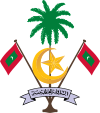Buddhism in the Maldives
[1] Western interest in the archaeological remains of early cultures on the Maldives began with the work of H. C. P. Bell, a British commissioner of the Ceylon Civil Service.
[3] According to a legend of the Maldivian Folklore, a prince named Koimala from India or Sri Lanka entered the Maldives from the North (Ihavandhu) and became the first king from the House of Theemuge.
Prior to that the Maldives had been settled by people of Dravidian origin from the nearest coasts, like the group today known as the Giravaaru who claim ancestry from ancient Tamils.
The Giraavaru people were just one of the island communities predating Buddhism and the arrival of a Northern Kingly dynasty and the establishment of centralized political and administrative institutions.
The ancient Maldivian Kings promoted Buddhism and the first Maldive writings and artistic achievements in the form of highly developed sculpture and architecture are from that period.



